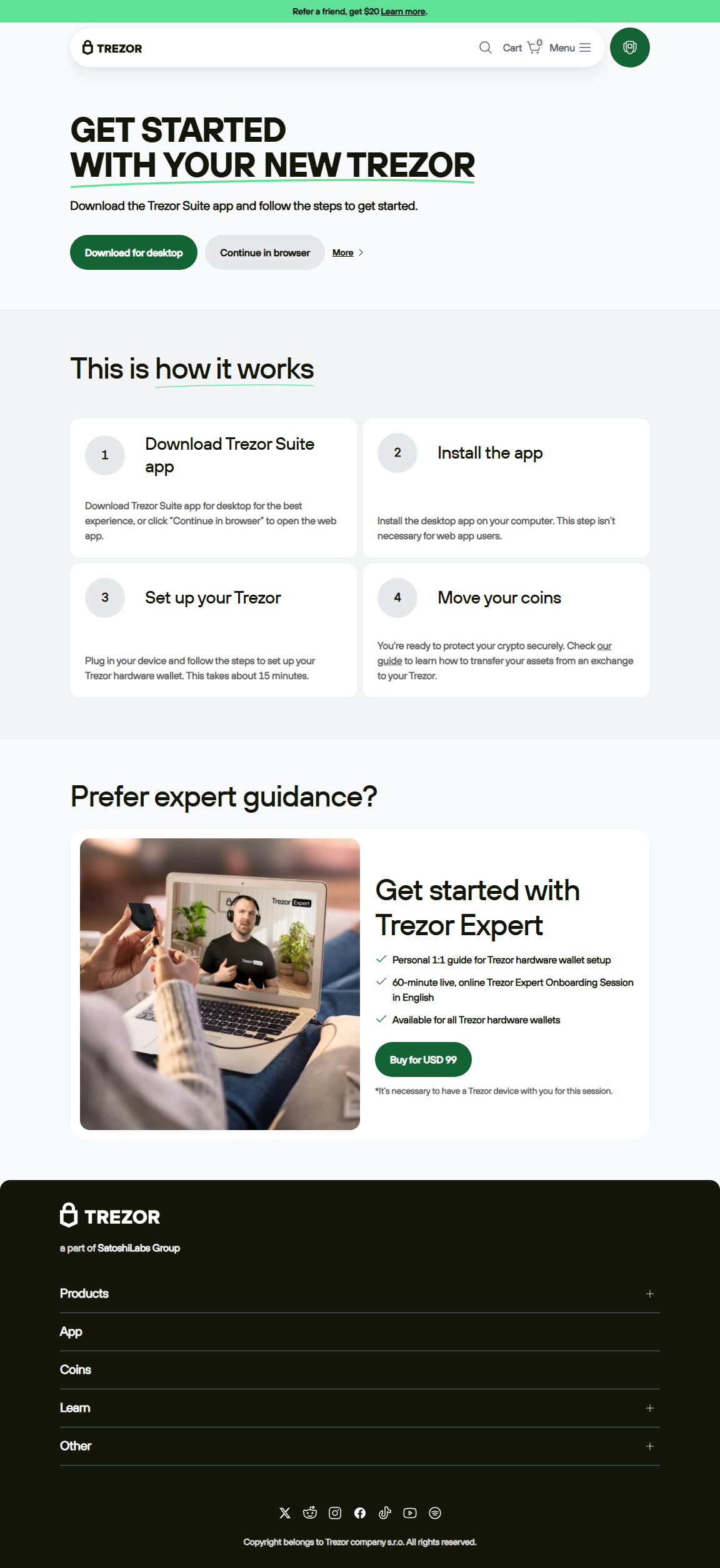Trezor Login: Accessing Your Crypto the Right Way
No usernames. No passwords. Just secure, self-sovereign crypto access done right.
What Does "Trezor Login" Really Mean?
Unlike traditional platforms where “logging in” means entering a username and password, Trezor login is fundamentally different. Your Trezor hardware wallet doesn’t rely on credentials stored on a server — it puts you in charge of your keys, your device, and your authentication process.
Logging into Trezor means connecting your device to a trusted interface — such as Trezor Suite — and confirming your identity via secure hardware interactions.
🔐 Trezor Login Is Not Cloud-Based
There is no website where you “log into” your Trezor account. Your keys are stored offline on your physical Trezor device, never in the cloud. When you plug in your device, Trezor Suite acts as your secure window to interact with the blockchain — nothing is uploaded or saved online.
How to Log In to Your Trezor Wallet (Step-by-Step)
Step 1: Connect Your Device
Use the USB cable provided with your Trezor (Model One or Model T) and connect it to your computer. Ensure the cable is original or compatible — some generic charging cables don't support data transfer.
Step 2: Open Trezor Suite
Download and open Trezor Suite — the official desktop or web app for interacting with your wallet. Only use links from trezor.io and verify the URL and certificate before continuing.
Step 3: Enter Your PIN
When prompted, use the randomized keypad on your screen and the numerical matrix displayed on your Trezor device to enter your secure PIN.
Step 4: (Optional) Enter Your Passphrase
If you’ve enabled the optional passphrase protection, you’ll be prompted to enter that now. This creates hidden wallet layers only accessible with the correct phrase.
Step 5: You’re In — Manage Your Assets
Once authenticated, you can now view balances, send and receive crypto, connect to DeFi apps, and more. You are essentially “logged in” to your wallet session — securely and offline.
⚠️ Common Login Mistakes to Avoid
- Searching "Trezor login" in Google: Avoid phishing sites. Go directly to
suite.trezor.ioor download fromtrezor.io. - Entering your seed phrase online: Never do this. Your recovery phrase is only for physical recovery — not for logging in.
- Skipping PIN/passphrase setup: These are critical for protecting your funds, especially in case of physical theft.
Trezor Login vs. Centralized Exchange Login
| Feature | Trezor Login | Exchange Login |
|---|---|---|
| User Credentials | PIN + hardware confirmation | Username & password |
| Storage of Private Keys | Offline on device | Online (custodial) |
| Login from Any Device? | No – physical access required | Yes – via web |
| Recovery Process | Seed phrase only | Email/password reset |
| Phishing Risk | Low (hardware approval) | High (email spoofing, etc.) |
Real-World Analogy: Your Wallet Is Your House Key
Imagine your Trezor is your front door key. If you lose access to a centralized exchange (like forgetting your password), you can reset it by calling the landlord. But with Trezor, you are the landlord. No one else can unlock the door — not Trezor, not your friend, not the internet.
Logging in with Trezor means you’re holding the key in your hand. There is no third party to bail you out if you lose it — but also, no third party can break in and steal your stuff.
✅ Quick Tips for Smooth Trezor Login
- Always keep your Trezor firmware updated through official tools
- Don’t share or store your recovery seed digitally
- Enable passphrase protection if you want an extra hidden wallet layer
- Bookmark Trezor Suite’s official page to avoid phishing
- Test recovery once by restoring from seed on a spare device (or practice wallet)
Frequently Asked Questions
Do I need an account to log in to Trezor?
No. Trezor does not use cloud accounts. You don’t register, sign up, or log in like on a website. You access your funds using your device + PIN + optional passphrase.
What if I lose my Trezor device?
You can restore access using your 12 or 24-word recovery seed on a new Trezor or compatible wallet. That seed is your only backup.
Can someone log in to my Trezor if they steal it?
Not without your PIN and passphrase (if used). Trezor wipes itself after multiple incorrect PIN attempts.
Can I use Trezor on multiple computers?
Yes. Trezor is portable — your wallet lives on the device, not the machine. You can plug it into any computer with Trezor Suite and access your crypto safely.
Conclusion: Rethinking the Idea of Login
When you shift to self-custody with Trezor, you're not just logging into a wallet — you're asserting control over your digital wealth. There's no centralized account, no company that "lets you in." The login process is about proving physical and cryptographic access.
Whether you're managing Bitcoin, Ethereum, or hundreds of other assets, always remember: you control your wallet, your keys, and your future.
Secure login is not about passwords. It’s about owning your hardware, your seed, and your sovereignty.
